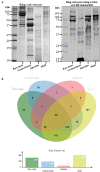Occupational Allergic Sensitization Among Workers Processing King Crab (Paralithodes camtschaticus) and Edible Crab (Cancer pagurus) in Norway and Identification of Novel Putative Allergenic Proteins
- PMID: 35387003
- PMCID: PMC8974837
- DOI: 10.3389/falgy.2021.718824
Occupational Allergic Sensitization Among Workers Processing King Crab (Paralithodes camtschaticus) and Edible Crab (Cancer pagurus) in Norway and Identification of Novel Putative Allergenic Proteins
Abstract
Introduction: Asthma and allergy occur frequently among seafood processing workers, with the highest prevalence seen in the crustacean processing industry. In this study we established for the first time the prevalence of allergic sensitization in the Norwegian king- and edible crab processing industry and characterized the IgE-reactive proteins. Materials and Methods: Two populations of crab processing workers participated; 119 king crab and 65 edible crab workers. The investigation included information on work tasks and health through a detailed questionnaire. Allergic sensitization was investigated by crab-specific IgE quantification and skin prick tests (SPT) to four in-house prepared crab extracts; raw meat, cooked meat, raw intestines and raw shell. Allergen-specific IgE binding patterns were analyzed by IgE immunoblotting to the four allergen extracts using worker serum samples. Total proteins in crab SPT extracts and immunoblot-based IgE binding proteins were identified by mass spectrometric analysis. Results: Positive SPTs were established in 17.5% of king- and 18.1% of edible crab workers, while elevated IgE to crab were demonstrated in 8.9% of king- and 12.2% of edible crab processing workers. There was no significant difference between the king and edible crab workers with respect to self-reported respiratory symptoms, elevated specific IgE to crab or SPT results. Individual workers exhibited differential IgE binding patterns to different crab extracts, with most frequent binding to tropomyosin and arginine kinase and two novel IgE binding proteins, hemocyanin and enolase, identified as king- and edible crab allergens. Conclusions: Occupational exposure to king- and edible crabs may frequently cause IgE mediated allergic sensitization. Future investigations addressing the diagnostic value of crab allergens including tropomyosin and arginine kinase and the less well-known IgE-binding proteins hemocyanin and enolase in a component-resolved diagnostic approach to crab allergy should be encouraged.
Keywords: allergy; crab; hemocyanin; ige antibody; occupational asthma; proteomics; shellfish; tropomyosin.
Copyright © 2021 Thomassen, Kamath, Bang, Nugraha, Nie, Williamson, Lopata and Aasmoe.
Conflict of interest statement
The authors declare that the research was conducted in the absence of any commercial or financial relationships that could be construed as a potential conflict of interest.
Figures




Similar articles
-
Occupational Exposure to Bioaerosols in Norwegian Crab Processing Plants.Ann Occup Hyg. 2016 Aug;60(7):781-94. doi: 10.1093/annhyg/mew030. Epub 2016 May 28. Ann Occup Hyg. 2016. PMID: 27235847
-
Revealing the Diverse Allergenic Protein Repertoire of Six Widely Consumed Crab Species: A Species-Specific Allergen in King Crab.Allergy. 2025 Jul 30. doi: 10.1111/all.16674. Online ahead of print. Allergy. 2025. PMID: 40736448
-
Molecular and immunological approaches in quantifying the air-borne food allergen tropomyosin in crab processing facilities.Int J Hyg Environ Health. 2014 Sep;217(7):740-50. doi: 10.1016/j.ijheh.2014.03.006. Epub 2014 Mar 26. Int J Hyg Environ Health. 2014. PMID: 24755444
-
IgE antibodies in occupational asthma: are they causative or an associated phenomenon?Curr Opin Allergy Clin Immunol. 2014 Apr;14(2):100-5. doi: 10.1097/ACI.0000000000000041. Curr Opin Allergy Clin Immunol. 2014. PMID: 24500297 Review.
-
Latex allergy in the workplace.Toxicol Sci. 2000 Nov;58(1):5-14. doi: 10.1093/toxsci/58.1.5. Toxicol Sci. 2000. PMID: 11053535 Review.
Cited by
-
Identification of the pan-allergen tropomyosin from the common bed bug (Cimex lectularius).Sci Rep. 2024 Mar 27;14(1):7281. doi: 10.1038/s41598-024-57877-3. Sci Rep. 2024. PMID: 38538827 Free PMC article.
-
Assessment of Occupational Exposure to Inhalable Aerosols in an Instant Powdered Food Manufacturing Plant in Norway.Saf Health Work. 2024 Sep;15(3):360-367. doi: 10.1016/j.shaw.2024.05.001. Epub 2024 May 15. Saf Health Work. 2024. PMID: 39309284 Free PMC article.
-
IgE-Mediated Shellfish Allergy in Children.Nutrients. 2023 Jun 11;15(12):2714. doi: 10.3390/nu15122714. Nutrients. 2023. PMID: 37375617 Free PMC article. Review.
-
Tissue-based skin prick test extracts from Atlantic salmon containing occupationally relevant allergens.Front Allergy. 2025 Jun 23;6:1525012. doi: 10.3389/falgy.2025.1525012. eCollection 2025. Front Allergy. 2025. PMID: 40626259 Free PMC article.
References
-
- FAO . The State of World Fisheries and Aquaculture 2020: Sustinability in Action. Rome: FAO; (2020). p. 244.
LinkOut - more resources
Full Text Sources

